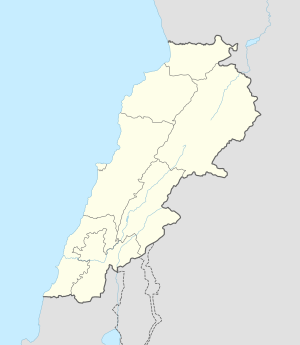Niha Chouf
|
Niha نيحا |
|
|---|---|

Niha City
|
|
| Location in Lebanon | |
| Coordinates: 33°35′41″N 35°37′49″E / 33.59472°N 35.63028°ECoordinates: 33°35′41″N 35°37′49″E / 33.59472°N 35.63028°E | |
| Country |
|
| Governorate | Mount Lebanon Governorate |
| District | Chouf District |
| Population | |
| • Total | 6,500 |
| Time zone | EET (UTC+2) |
| • Summer (DST) | +3 (UTC) |
Niha (Arabic: نيحا [ˈniħa]) is a town in the Chouf which belongs to Mount Lebanon of Lebanon. The town is 44 miles from Beirut and it has about 3,750 hectares; there are 6,500 inhabitants approximately with a Druze majority and Christian minority. However, there are only two public schools in the city. It is famous because of its olive groves and its grapes, apples, plums and almonds production. Its tourist attractions are The church of Saint Joseph, El Qa'ah Spring, The prophet Job tomb and The Niha's Castle. Like all Lebanon's corners Niha owns whether cultural or historical richness that dwells in the heritage of this country. The renowned Lebanese singer Wadih El Safi was born in Niha, and he's one of the most important mawwal performers of Lebanon and in the Middle East. The population speaks Lebanese Arabic.
The name Niha is used by four Lebanese cities: Niha, Zahlé; Niha, Batroun; Niha, Tyre and Niha, Chouf. The word neeha is Syriac and denotes to the place the character of calm, peaceful
According to a false Druze legend there is a relatively modern structure located in a hill overlooking Niha town in the Chouf that is supposed to be the burial site of the prophet Job. Niha is one of the most known destinations. There are many caves, natural and man-made. One among them, a cave-fortress that was cut into a cliff during the Crusades between 1165–1260, is named Niha's Castle or Shakif Tiron. According to the popular tale prince Fakhreddine El Ma'ani II hid there when fleeing of the Ottomans in 1635. However, the accurate historic version links these events to prince's father: Korkomaz during 1584.
...
Wikipedia

